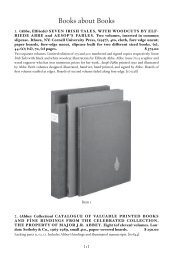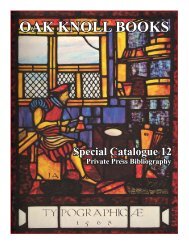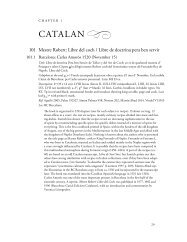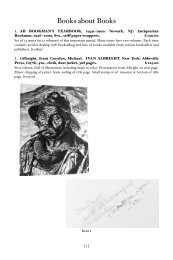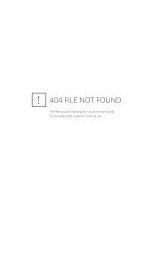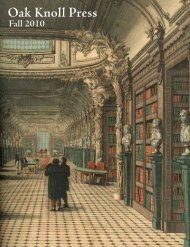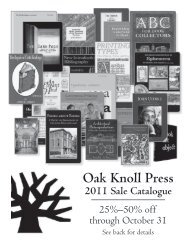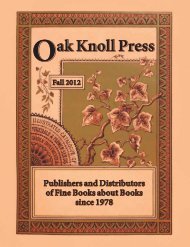View Excerpt (PDF) - Oak Knoll Books
View Excerpt (PDF) - Oak Knoll Books
View Excerpt (PDF) - Oak Knoll Books
You also want an ePaper? Increase the reach of your titles
YUMPU automatically turns print PDFs into web optimized ePapers that Google loves.
Andrea Krupp<br />
themselves are a rich source of empirical information, and repositories<br />
such as the Library Company of Philadelphia hold them in plentiful<br />
supply. Since 1995, the Library Company’s Chief of Conservation,<br />
Jennifer Woods Rosner, and I have been compiling data about the structure<br />
and appearance of cloth-covered bindings in our collection. The<br />
Database of Nineteenth-century Cloth Bindings currently contains<br />
data on approximately 3,000 books published between 1824 and 1900.<br />
Each entry comprises over sixty ‰elds of information that record the<br />
details of the book’s structure and appearance. This article focuses on<br />
two of those recorded elements: the date of publication as given on the<br />
title-page and the grain of the cloth. While compiling the database we<br />
identi‰ed 160 new bookcloth grain patterns. The majority of them,<br />
135, ‰rst appear on American books published before 1850. By way of<br />
comparison, current resources illustrate ‰fty-seven diˆerent bookcloth<br />
grains, and only seventeen of them are pre-1850 patterns.<br />
The study of nineteenth-century bookbindings is advancing with<br />
increased attention to the materiality of the book and the information<br />
that can be gleaned from it, because documentary evidence is so rare.<br />
Accordingly, the study of bookcloth grain patterns by necessity must<br />
progress towards increasingly detailed and speci‰c identi‰cation and away<br />
from generalized divisions of grain patterns by family. The large number<br />
of bookcloth grains that has been amassed underscores the need for a<br />
detailed and accurate “‰eld guide” that records individual cloth grain patactual<br />
patents having burned in the great Patent O‹ce ‰re of 15 December 1836.<br />
Three of these were especially promising: a ribbon smoothing and glossing machine,<br />
1817; cloth dressing and ornamenting, 1821; manufacture of ‰gured fabrics, 1834.<br />
Both totals include 104 “ribbon-embossed” patterns. These decorative bookcloth<br />
grain patterns in Šoral, geometric, and abstract designs are discussed later in<br />
this article. Their dates of use range from the early to mid-1830s through the 1840s.<br />
Photographs of cloth grains appear in the following books: Sadleir, The<br />
Evolution of Publishers’ Binding Styles; Carter, Binding Variants; Rogers, “The Rise<br />
of American Edition Binding”; Sadleir, XIX Century Fiction: A Bibliographical<br />
Record Based on His Own Collection, 2 vols. (London: Constable; Berkeley, CA:<br />
California Univ. Press, 1951; reprinted, 1969); Jacob Blanck and Michael Winship,<br />
Bibliography of American Literature, 9 vols. (New Haven, CT: Yale Univ. Press, 1955–<br />
91); G. Thomas Tanselle, “The Bibliographical Description of Patterns,” Studies in<br />
Bibliography 23 (1970): 71–102; Philip Gaskell, A New Introduction to Bibliography<br />
(Oxford: Clarendon, 1972); Ball, Victorian Publishers’ Bindings.



